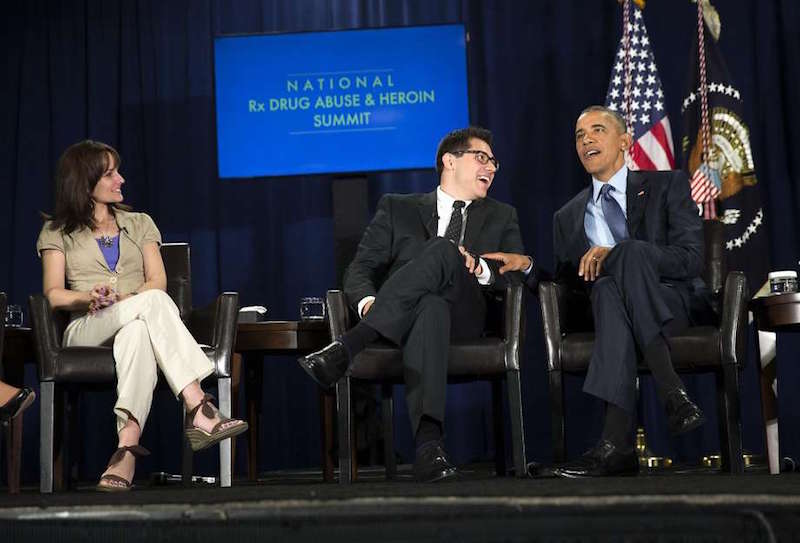
Americans are hurting. Physically.
With 40 percent of workers in low-wage jobs, 40 percent of households with few or no assets, nearly one-third of Americans living in or near poverty, and median middle-class household incomes lower than they were in 2000, movements ranging from the Donald Trump and Bernie Sanders campaigns to Fight for $15 and Occupy Wall Street have made it abundantly clear that a sizable proportion of the population is suffering economically.
Less noticed has been the simultaneous sharp increase during the last decade and a half in neck and back pain, depression, and difficulty engaging in modest activities like climbing a flight of stairs or even shopping. This long-silent pain epidemic burst into public consciousness in recent months, as opioid addiction and abuse have suddenly drawn scrutiny by political leaders from President Obama to the Senate, which, in a rare moment of bipartisanship, voted 94-1 last month to address painkiller abuse. Why are Americans, with 5 percent of the world’s population, consuming 80 percent of the planet’s prescription painkillers, drugs like Oxycodone that have been called “hillbilly heroin”?
Emotional, physical distress
The all-too-belated recognition that disproportionate numbers of Americans experiencing pain are low-income and marginalized reflects a political class whose denial is either stunning or as hollow as that of Captain Renault in “Casablanca” declaring that he was “shocked” at the presence of gambling. But to ignore the connections between increased pain and an economy that has left too many in the dust is extremely shortsighted.
Last fall’s National Academies of Sciences study by Nobel Prize-winner Angus Deaton and his wife, Anne Case, both economists at Princeton University, and subsequent analyses have drawn considerable attention to the rise in mortality and the decline or flat-lining of life expectancy among middle-aged, less-educated white Americans. However, less noticed have been their, and others’, findings on rising midlife morbidity — self-reports showing that growing numbers of Americans experience more pain, psychological distress, difficulties with the activities of daily living and alcohol abuse.
Perhaps, the most astonishing finding was that the number of days per month that these midlife whites said that their physical health was not good rose from about one to four between 1997-99 and 2011-13, with a similar rise from one to four days in which their mental health was not good. One in 3 reported chronic neck pain, 1 in 5 chronic neck pain and 1 in 7 sciatica, and the fraction reporting that they had more than a little difficulty with daily tasks like taking a short walk, standing and socializing also increased markedly. Although obesity has sharply increased — hardly a sign of good public health — Case and Deaton found little relation between obesity and pain.
The number of opioid prescriptions written has tripled and heroin and heavy alcohol use have gone up since the 1990s, as millions of Americans appear to be self-medicating. At the same time, the incidence of depression edged upward, while antidepressant use has increased by 400 percent since the mid-1990s, according to the Centers for Disease Control. The CDC also reports that nearly 1 in 5 adults has an anxiety disorder and that mental illness is more common in the same less-educated, low-income and economically distressed South Central and Rust Belt states where life expectancy has gone down. Similarly, the number of Americans so disabled by mental disorders that they qualify for Social Security Disability Insurance or Supplemental Security Income went up nearly 2½ times between 1987 and 2007.
Deaton says that he cannot say what is causing the rise in pain, but a February study reported in the journal Psychological Science found that unemployment and inability to pay one’s bills were correlated to higher levels of reported pain and consumption of painkillers. As the study’s lead author, Eileen Chou of the University of Virginia, said, “Overall, our findings reveal that it physically hurts to be economically insecure.”
Beyond the physical suffering, the costs of pain are enormous. With estimates of the number of adults in pain ranging from 40 million to 100 million, the annual medical bill and cost in lost productivity has been estimated at $600 billion, with an additional cost to taxpayers of about $140 billion.
The gender dimensions of the pain also yield a conflicting picture. On the one hand, rising pain and disability rolls parallel the declining proportion of men working, as 3 in 10 males over age 20 do not work today compared with 1 in 10 in 1960. On the other, while men accounted for most of the nation’s 43,000 suicides last year, women are much more likely to attempt suicide and account for the lion’s share of the half million Americans admitted to hospitals because of self-harm. A quarter of middle-aged women were taking antidepressants in 2008. Moreover, rising morbidity and mortality appear to be most affecting poor, rural and working-class white women.
Seeing the complete picture
The connections between pain, economics, unhappiness and politics are not clear but are highly suggestive. With popular anger toward big business and government at record levels, just one-third of Americans tell pollsters that they are “very happy,” a majority of workers do not like their jobs, and barely a quarter of Americans say that the country is “headed in the right direction.” Unhappiness, pessimism, and anger are likely to presage either more extreme politics or more civic disengagement. If problems seem so unfixable, why bother trying? Just rant on.
It is foolish to silo America’s economic, political and pain/mortality problems. Attacking opioid addiction and the pain behind it, a broken government, low wages and retirement insecurity simply cannot continue to be separate conversations.
Andrew L. Yarrow is a Senior Fellow at the Financial Security Program. This article first appeared in the San Francisco Chronicle on May 5, 2016.
Back to the FSP homepage.
